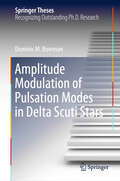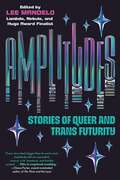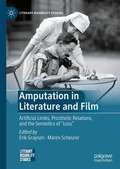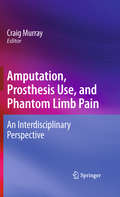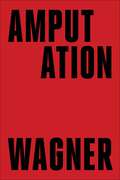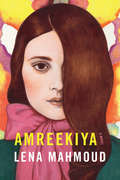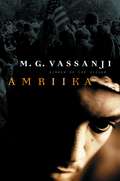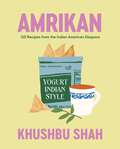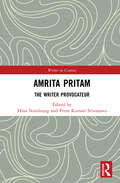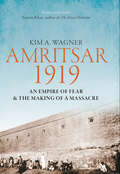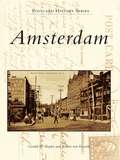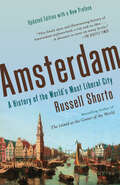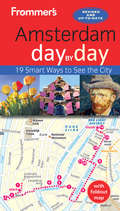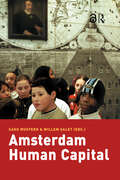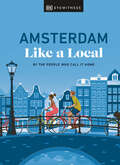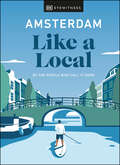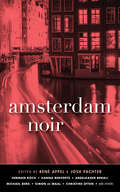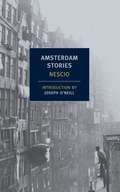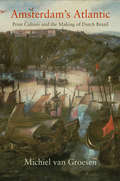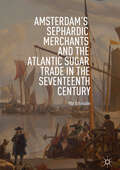- Table View
- List View
Amplitude Modulation of Pulsation Modes in Delta Scuti Stars (Springer Theses)
by Dominic M. BowmanThis outstanding thesis by Dominic Bowman provides a thorough investigation of long-standing questions as to whether amplitude modulation is astrophysical, whether it offers insights into pulsating stars, and whether simple beating of modes with stable amplitudes is unrecognised because of a lack of frequency resolution. In this thesis, the author studied a uniform sample of 983 delta Scuti stars—the most common type of main-sequence heat engine pulsator—that were observed nearly continuously for 4 years at stunning photometric precision of only a few parts per million by the Kepler space mission. With no mission planned to supersede the Kepler 4-year data set, this thesis will stand as the definitive study of these questions for many years. With revolutionary photometric data from the planet-hunting Kepler space mission, asteroseismic studies have been carried out on many hundreds of main-sequence solar-type stars and about 10,000 red giants. It is easy to understand why those stochastically driven stars have highly variable amplitudes. Over much of the rest of the Hertzsprung–Russell (HR) diagram, stellar pulsations are driven by heat mechanisms, which are much more regular than the stochastic driving in solar-like pulsators. Yet for decades, amplitude and frequency modulation of pulsation modes have been observed in almost all types of heat-driven pulsating stars. The author shows that the amplitude and frequency modulation are astrophysical, and he has investigated their implications and prospects to provide new insights into the delta Scuti stars and the many other types of heat-engine pulsators across the HR diagram.
Amplitudes: Stories of Queer and Trans Futurity
by Lee MandeloRevolutionary and visionary, these twenty-two speculative stories edited by Lambda, Nebula and Hugo finalist Lee Mandelo explore the vast potentialities of our queer and trans futures. From self-styled knights fighting in dystopian city streets to conservationists finding love in the Appalachian forests; from social media posts about domestic &“bliss&” in a lottery-based, state-housing skyscraper to herding feral cats off of one&’s scientific equipment; from street drugs that create doppelgangers to dance-club cruising at the edge of the galaxy—Amplitudes: Stories of Queer and Trans Futurity interrogates the farthest borders of the sci-fi landscape to imagine how queer life will look centuries in the future—or ten years from now. Filled with brutal honesty, raw emotions, sexual escapades, and delightful whimsy, Amplitudes speaks to the longstanding tradition of queer fiction as protest. This essential collection serves as an evolving map of our celebrations, anxieties, wishes, pitfalls, and—most of all—our rallying cry that we're here, we're queer—and the future is ours! Inventive, moving, and hopeful, this fresh anthology contains never before published stories by some of our most prominent and emerging LGBTQIA+ writers, including: Esther Alter • Bendi Barrett • Ta-wei Chi, trans. Ariel Chu • Colin Dean • Maya Deane • Dominique Dickey • Katharine Duckett • Meg Elison • Paul Evanby • Aysha U. Farah • Sarah Gailey • Ash Huang • Margaret Killjoy • Wen-yi Lee • Ewen Ma • Jamie McGhee • Sam J. Miller • Aiki Mira, trans. CD Covington • Sunny Moraine • Nat X. Ray • Neon Yang • Ramez Yoakeim
Amputation in Literature and Film: Artificial Limbs, Prosthetic Relations, and the Semiotics of "Loss" (Literary Disability Studies)
by Maren Scheurer Erik GraysonAmputation in Literature and Film: Artificial Limbs, Prosthetic Relations, and the Semiotics of “Loss” explores the many ways in which literature and film have engaged with the subject of amputation. The scholars featured in this volume draw upon a wide variety of texts, both lesser-known and canonical, across historical periods and language traditions to interrogate the intersections of disability studies with social, political, cultural, and philosophical concerns. Whether focusing on ancient texts by Zhuangzi or Ovid, renaissance drama, folktales collected by the Brothers Grimm, novels or silent film, the chapters in this volume highlight the dialectics of “loss” and “gain” in narratives of amputation to encourage critical dialogue and forge an integrated, embodied understanding of experiences of impairment in which mind and body, metaphor and materiality, theory and politics are considered as interrelated and interacting aspects of disability and ability.
Amputation, Prosthesis Use, and Phantom Limb Pain: An Interdisciplinary Perspective
by Craig MurrayThe book will contain contributions from the fields of anthropology, biomedical engineering, computer science, neuroscience, nursing, prosthetics and orthotics, psychology, and rehabilitative medicine. It will be comprised of three broad interrelated sections. Following an introductory chapter in which the topics and chapters of the book are overviewed, the first section ("Providing and Monitoring the Use of Prostheses") will concentrate on the work of prostheticians and will consist of three chapters. The first of these, written by a clinician responsible for the provision of prosthetics in a large regional area of the UK, will present a range of ethical and medico-legal issues for rehabilitation professionals in the supply and withdrawal of prostheses and assistive technology for people with limb loss or deformity. The second chapter, provided by a prosthetician and prosthetic engineers, will present the development of an innovative computerized technique for monitoring upper limb prosthesis activity. The final chapter in this section is written by an anthropologist, himself an amputee, presenting ethnographic work on how prostheticians and their clients actually "go about" providing artificial limbs. Together these chapters explicate the processes involved in prostheticians' work with clients in a manner which will be of interest to students and professionals from a range of disciplines. Section 2 ("The Experience and Meaning of Prosthesis Use") focuses on the experiences and meanings of prosthesis users themselves. The first of three chapters, written by members of the Dublin Psychoprothetics Group, explores the ways in which people adapt and cope with limb loss and using a prosthesis, the potential for positive adjustment and strengths emerging from the experience, pain, affective distress, issues around identity, body image, and the construction of self and quality of life. It also considers the importance of these issues for health service providers across the multidisciplinary team who work with people with limb loss. The second chapter provides a reflective critique of the themes in the book, namely, the process of prosthetic rehabilitation, by way of a reprint of Gelya Frank's classic paper "Beyond Stigma: Visibility and Self-Empowerment of Persons with Congenital Limb Deficiencies," along with a new commentary from the author herself. This chapter focuses on the experiences of people born with congenital limb deficiencies who have chosen not to use prosthetics as part of a strategy to counteract the stigmatization of disability and bodily difference. The views of these participants provide challenges to a range of professionals involved in the rehabilitation of people with amputations and limb deficiencies. The final chapter of this section presents a range of themes in the experiences of people who choose to use prosthetics following amputation or limb absence, including the embodied used of prosthesis and the integration of these into the identity of the persons concerned. The final section (postoperative pain and new treatments of phantom limb pain) focuses on phantom limb pain and emerging therapies for this phenomenon. The first of four chapters presents a clinician's account of post amputation pain, stressing how this is temporally dependent, varying at different stages of the perioperative/postoperative period, with possibly more than one pain being present at any time. In considering the complex amalgam of pain contributors the author argues for a full biopsychosocial assessment to be made with attention and treatment given to any associated mood disorder, disorder of cognition or behavioral maladaptations. These considerations are developed further in the following chapter where, written from a nursing perspective, the coping style of patients in relation to phantom limb pain are discussed and compared with other pain conditions. The final two chapters in this section present two emerging therapies for phantom limb pain which have received particular academic and media attention. This condition ...
Amputation: A Novel
by Bruce WagnerAMPUTATION is the first novel to be written about the inferno that obliterated two Los Angeles cities in January of 2025. Major characters are comedian Stephen Colbert; Karen Bass; a Timothée Chalamet stunt double; a fiercely pro-Palestinian heiress and her Zionist father; disgraced Grey&’s Anatomy writer Elisabeth Finch and a failed indie film producer——along with an assorted battalion of ordinary people, opportunists and looters. A fable drenched in hyperrealism, AMPUTATION is a burnt jewel box showcasing Wagner's transcendent, scabrously poetic powers as he explores the lives (and deaths) of the fire victims, and the consequences of dereliction, delusion, incompetence——and impermanence.
Amreekiya: A Novel (University Press of Kentucky New Poetry & Prose Series)
by Lena MahmoudA touching debut novel chronicling the life a young Palestinian American woman between two cultures as she comes of age and as she settles into marriage.Isra Shadi, a twenty-one-year-old woman of mixed Palestinian and White descent, lives in California with her paternal amu (uncle), amtu (aunt), and cousins after the death of her mother and abandonment by her father at a young age. Ever the outcast in her amu and amtu’s household, Isra is encouraged to marry and leave. After rejecting a string of undesirable suitors, she marries Yusef, an old love from her past . . .In Amreekiya, author Lena Mahmoud deftly juggles two storylines, alternating between Isra’s youth and her current life as a married twentysomething who is torn between cultures and trying to define herself. The chapters chronicle various moments in Isra’s narrative, including her parents volatile relationship and the trials and joys of forging a partnership with Yusef. Mahmoud also examines Isra’s first visit to Palestine, the effects of sexism, how language affects identity, and what it means to have a love that overcomes unbearable pain.An exploration of womanhood from an underrepresented voice in American literature, Amreekiya is simultaneously unique and relatable. Featuring an authentic array of characters, Mahmoud’s first novel is a much-needed story in a divided world.Praise for Amreekiya“A subversive story about love and marriage . . . a feminist Palestinian project that follows its headstrong lead, Isra, through struggle and loss. This is a tense examination of what a marriage is and how gendered expectations influence love and family. It is an intimate dissection of a relationship that exists in an unequal world . . . . Mahmoud portrays the unsettling conflict between freedom and social imprisonment in Amreekiya, an unnerving novel that encourages questioning common assumptions, no matter how deep down they rest.” —Foreword Reviews“Both wise and humorous, Mahmoud’s debut novel is an intimate portrayal of an early Arab American marriage, filled with passion, loss, and ultimately forgiveness. Readers will be moved by the fierce but fragile Isra, who refuses to be defined by her family, her husband, and her society.” —Susan Muaddi Darraj, author of A Curious Land: Stories from Home“Yusef and Isra’s story is relevant for people worldwide. With poignant, beautiful writing, Mahmoud quickly draws readers into the novel, portraying all her characters with a sympathetic voice. A fantastic choice for book discussions and well worth a second reading.” —Library Journal (starred review)
Amriika
by M. G. VassanjiAmriikais a novel of betrayal, disillusionment, and discovery set in America during three highly charged decades in the nation’s history. In the late sixties, Ramji, a student from Dar es Salaam, East Africa, arrives in an America far different from the one he dreamed about, one caught up in anti-war demonstrations, revolutionary lifestyles, and spiritual quests. As Ramji finds himself pulled by the tumultuous currents of those troubled times, he is swept up in events whose consequences will haunt him for years to come. Decades later in a changed America, having recently left a marriage and a suburban existence, an older Ramji, passionately in love, finds himself drawn into a set of circumstances which hold terrifying reminders of the past and its unanswered questions.
Amrikan: 125 Recipes from the Indian American Diaspora
by Khushbu Shah“What is Indian food in America?” In her eagerly anticipated debut cookbook, acclaimed food writer Khushbu Shah injects an electric and irresistible energy into the story of Indian food, with 125 recipes inspired by the cooking of the diaspora. From the savory and bold flavors of Achari Paneer Pizza to the ultimate home-cooked comfort meal, a pot of Spinach Tadka Dal with rice, Khushbu’s recipes are flavor-packed, party-pleasing, and wonderfully surprising. She invites readers on a journey far beyond butter chicken (though she has a stellar recipe for it), offering instructions for preparing meals, drinks, and desserts as diverse as Saag Paneer Lasagna, Classic Dosas, Keralan Fried Chicken Sandwiches, Pani Puri Mojitos, and a Masala Chai Basque Cheesecake. Khushbu makes it easy to dive in, equipping home cooks with a list of simple-to-find pantry staples alongside vibrant images, clever tips and tricks, and illuminating essays that introduce a thrilling voice in American food.
Amrita
by Banana Yoshimoto Russell F. WasdenSakumi loses a sister to suicide, then loses her own memory in a fall. This novel follows her surreal literal and emotional journeys to find herself.
Amrita Pritam: The Writer Provocateur (Writer in Context)
by Hina Nandrajog and Prem Kumari SrivastavaAmrita Pritam was a prominent Punjabi poet, novelist, and essayist who captured the realities of everyday life in the India of the early 1900s India and presented the unique voices of the women of the Indian subcontinent. This book offers a comprehensive understanding of the writer’s work by situating it in the context of not just Punjabi literature but Indian literature, while showcasing their continued relevance in contemporary times. With a career spanning over six decades, she Pritam produced over 100 books of poetry, fiction, biographies, essays, a collection of Punjabi folk songs and an autobiography that were all translated into several Indian and foreign languages. This volume includes critical essays on her works as well as a selection of her poems and stories in translation including, ‘A Call to Waris Shah’ (Ajj Aakhaan Waris Shah nu), The Skeleton (Pinjar) and Village No. 36 (Khabarnama Te Chak No. 36) and excerpts from other prominent writings to give readers a glimpse into Pritam’s her rich literary oeuvre as well as her legacy in a post-colonial India which is still grappling with many of the same taboos around gender, national and religious identity and women’s sexuality. It discusses the diversity of themes and socio-cultural realities in her writings works focusing especially on her writings on Punjab, agency of her women protagonists, national and communal identities and the testimonies of the traumas which the cataclysmic 1947 Partition of India brought on women. A writer who consistently subverted the existing social, political and patriarchal structures of her times, both in her life and in her writings, this book encapsulates the relevance of her writing and her voice in our times. Part of the ‘Writer in Context’ series, this book will be useful for scholars and researchers of Indian literature, Hindi literature, Punjabi Literature, English literature, postcolonial studies, cultural studies, global south studies and translation studies.
Amritsar 1919: An Empire of Fear & the Making of a Massacre
by Kim A. Wagner“Chronicles the run up to Jallianwala Bagh with spellbinding . . . focus. . . . Mr. Wagner’s achievement is one of balance . . . and, above, all, of perspective.” (The Wall Street Journal)The Amritsar Massacre of 1919 was a seminal moment in the history of the British Empire, yet it remains poorly understood. In this dramatic account, Kim A. Wagner details the perspectives of ordinary people and argues that General Dyer’s order to open fire at Jallianwalla Bagh was an act of fear. Situating the massacre within the “deep” context of British colonial mentality and the local dynamics of Indian nationalism, Wagner provides a genuinely nuanced approach to the bloody history of the British Empire.“Mr Wagner argues his case fluently and rigorously in this excellent book.” —The Economist“Written with a humane commitment to the truth that will impress.” —The Times“Skillfully maps a tale of growing tensions, precipitate action, and troubled aftermath.” —The Telegraph“A compelling account” —Financial Times“Wagner's postmortem of an imperial disaster should be widely read.” —R.A. Callahan, emeritus, Choice“The fullest, and by far the most authoritative, account of the causes and course of the Jallianwala massacre in any language.” —Nigel Collett, author of The Butcher of Amritsar“Mining a variety of sources – diaries, memoirs and court testimonies—[Wagner] uncovers fresh perspectives and examines the relation between colonial panic and state brutality with sophistication, sincerity and style.” —Santanu Das, author of India, Empire, and First World War Culture“Analytically sharp but gripping to read, the book is a page-turner”—Barbara D. Metcalf, co-author of A Concise History of India“An important book.” –Yasmin Khan, author of The Partition
Amsco's Science Grade 8
by Paul S. Cohen Anthony V. SorrentinoProvides a clear and concise presentation of middle school science concepts. This book discusses current ideas in science taken straight from the headlines.
Amsco's Science, Grade 7
by Paul S. Cohen Anthony V. SorrentinoProvides a clear and concise presentation of middle school science concepts.
Amskapi Pikuni: The Blackfeet People
by Alice Beck Kehoe Clark WisslerWritten in collaboration with Blackfoot tribal historians and educators, Amskapi Pikuni: The Blackfeet People portrays a strong native nation fighting for two centuries against domination by Anglo invaders. The Blackfeet endured bungling, corrupt, and drunken agents; racist schoolteachers; and a federal Indian Bureau that failed to disburse millions of dollars owed to the tribe. Located on a reservation in Montana cut and cut again to give land to white ranchers, the Blackfeet adapted to complete loss of their staple food, bison—a collapse of what had been a sustainable economy throughout their history. Despite all of these challenges, the nation held to its values and continues to proudly preserve its culture.
Amsterdam
by Robert H. von Hasseln Gerald R. SnyderIn the 1700s, Amsterdam was just a small trading village in upstate New York. Utilizing its superior location astride critical waterways, the village grew during the westward expansion of the early 1800s to become an industrial powerhouse. By the 20th century, Amsterdam had become America's foremost rug-making center, nicknamed the "Carpet City," and the seventh largest city in New York. Waves of Dutch, German, Irish, Italian, and eastern European immigrants were drawn to the city for work. Some became mill workers while others became millionaires. The vintage postcards in Amsterdam tell the story of an American dream created, lost, and still pursued on what was once America's frontier.
Amsterdam
by Russell ShortoAn endlessly entertaining portrait of the city of Amsterdam and the ideas that make it unique, by the author of the acclaimed Island at the Center of the World Tourists know Amsterdam as a picturesque city of low-slung brick houses lining tidy canals; student travelers know it for its legal brothels and hash bars; art lovers know it for Rembrandt's glorious portraits. But the deeper history of Amsterdam, what makes it one of the most fascinating places on earth, is bound up in its unique geography-the constant battle of its citizens to keep the sea at bay and the democratic philosophy that this enduring struggle fostered. Amsterdam is the font of liberalism, in both its senses. Tolerance for free thinking and free love make it a place where, in the words of one of its mayors, "craziness is a value." But the city also fostered the deeper meaning of liberalism, one that profoundly influenced America: political and economic freedom. Amsterdam was home not only to religious dissidents and radical thinkers but to the world's first great global corporation. In this effortlessly erudite account, Russell Shorto traces the idiosyncratic evolution of Amsterdam, showing how such disparate elements as herring anatomy, naked Anabaptists parading through the streets, and an intimate gathering in a sixteenth-century wine-tasting room had a profound effect on Dutch-and world-history. Weaving in his own experiences of his adopted home, Shorto provides an ever-surprising, intellectually engaging story of Amsterdam from the building of its first canals in the 1300s, through its brutal struggle for independence, its golden age as a vast empire, to its complex present in which its cherished ideals of liberalism are under siege.
Amsterdam Anatomy Lessons Dissected
by Thomas Gulik Frank IJpmaThis book gives the historical perspective of 17th century Dutch paintings for ‘Anatomy lessons’ using pairning that were created for the Surgeons’ Guild in Amsterdam, to aid surgeons in teaching and knowledge. The iamges show the corpse and dissections are described and discussed.
Amsterdam Day by Day: 4th Edition
by Sasha HeseltineThough the architecture of its central district is unchanged since the 1700s, Amsterdam is one of the most modern cities of Europe in terms of its lifestyles and public policies. This 184-page Day by Day Guide, profusely illustrated with four-color photos and maps, carefully guides you to the most absorbing, the most revealing, of the city's attractions. While its main emphasis is on wisely allocating your time in Amsterdam (day by day itineraries), the book otherwise deals with practicalities: hotels, meals, museums, shops and nightlife.
Amsterdam Human Capital
by Sako Musterd Willem SaletThe familiar shape of western cities is changing dramatically. For long times the urban core was taken for granted as the focal point for international contacts and day-to-day activities in the region. Currently, the urban scope is transforming into multi centred forms at metropolitan scale. The transition is not just a matter of spatial form, it is reflecting social, economic and cultural processes. The question is what new identities may develop in such changing historical conditions of space and place.This book is a first attempt to analyse the process of urban transformation in an integral way. The focus is on the region of Amsterdam. All contributions are written by senior researchers of the Amsterdam studycentre for the Metropolitan Environment (AME). AME is the interdisciplinary urban research institute of the Universiteit van Amsterdam.As the urban research institute at the Universiteit van Amsterdam, the Amsterdam studycentre for the Metropolitan Environment (AME) analyses the economic, social and cultural aspects of this spatial transformation, usually in international comparative research. All contributions to this book are written by senior researchers of AME in an attempt to analyse in an integral way the present and future dilemmas out of the historical growth paths of this dynamic city.
Amsterdam Like a Local: By the People Who Call It Home (Local Travel Guide)
by Nellie Huang DK Eyewitness Elysia Brenner Michael MordechayAre you keen to explore a different side of Amsterdam? Like a Local is the book for you.This isn't your ordinary travel guide. Beyond Amsterdam's monolithic museums are family-run bakeries, waterside parks, and down-to-earth jazz bars that locals love - and that's where this book takes you.Turn the pages to discover:- The small businesses and community strongholds that add character to this vibrant city, recommended by true locals- 6 themed walking tours dedicated to specific experiences such as vintage shopping and sampling Dutch spirits- A beautiful gift book for anyone seeking to explore Amsterdam- Helpful what3word addresses so that you can pinpoint all the listed sights- A thoughtfully updated second edition, including new places to visitCompiled by three proud Amsterdammers and revised and updated for 2024, this stylish travel guide is packed with the city's best experiences and secret spots, handily categorized to suit your mood and needs.Whether you're a restless local on the hunt for a new hangout or a visitor keen to discover a side you won't find in traditional guidebooks, Amsterdam Like A Local will give you all the inspiration you need.
Amsterdam Like a Local: By the people who call it home (Local Travel Guide)
by Nellie Huang DK Eyewitness Elysia Brenner Michael MordechayIf you&’re looking for the ultimate European getaway, Amsterdam won&’t disappoint!Iconic canals, centuries-old townhomes, cobblestone lanes and flower-adorned bridges. Amsterdam is truly one-of-a-kind and offers so many different kinds of experiences. Use the travel tips from this ultimate Amsterdam travel book to plan your trip to the Netherlands!Beyond the well-trodden sights, there&’s a secret side of the city — and who better to guide you to it than the locals? This travel guide to Amsterdam includes: • Two-color, bold, modern design with contemporary illustrations throughout • Authors are true locals and have been picked for having their fingers on the pulse and their diverse tastes. Their suggestions and advice sit alongside quotes from Amsterdam creatives, performers, volunteers and business leaders to give the book a local feel • A narrative style throughout, making the local, personal voice central to every entry • Structured by six themes and subsequent sub-themes — rather than areas — to echo how people are traveling, rather than where. For example, Eat, Drink, Shop, Art and Culture, Nightlife • Each entry includes its unique address so readers can pinpoint precisely where they are heading • Each theme ends with a tour spread, dedicated to a specific interest or experience. For example, A Foodie Tour of Oud-West, and Art and Antiques Shopping in the Spiegelkwartier Amsterdam is as pretty as a postcard! You can&’t walk a mile without bumping into a masterpiece in this city. Besides its cultural attractions like the Anne Frank House, Rijksmuseum, and Van Gogh museum, the Dutch capital also has leafy parks, hip shops, craft breweries and some of Europe's hottest clubs. From taking a bicycle tour through the polder landscape in Amsterdam Noord to relaxing at a canalside bruin café (traditional Dutch pub) in Jordaan, this Amsterdam guidebook helps you to experience the real side of Amsterdam.Additional tidbits to expand your experience are peppered throughout this local guide to Amsterdam. For example, local tips and recommendations for exploring this vibrant city, secret places that only a local would know, hands-on experiences (cookery classes and art workshops), and ideas for traveling solo, in a pair and in a crowd. It also includes tips on how to travel sensibly in a post-Covid world without compromising on experience.From New York and London to Paris and Tokyo, there are more places to discover with these niche local guides! Written by the people who call it home, the Like A Local series from DK takes you beyond the tourist track to experience the heart and soul of each city!
Amsterdam Noir (Akashic Noir)
by Herman Koch Hanna BervoetsThis anthology of new noir fiction set in the Dutch capital &“features superior writing from authors largely unknown to an American audience&” (Publishers Weekly). From its numerous coffee shops where drugs are openly available, to its world-famous Red Light District where prostitutes display themselves in shop windows, Amsterdam is a city where almost anything goes in broad daylight. And yet, this serene city of canals has its dark side as well. In fifteen tales of greed, jealousy and revenge, some of the finest Dutch crime writers—including literary award-winners and international bestsellers—explore the seamy shadows of this historic city. Amsterdam Noir features brand-new stories by: Michael Berg, Anneloes Timmerije, Murat Isik, René Appel & Josh Pachter, Simon de Waal, Hanna Bervoets, Karin Amatmoekrim, Christine Otten, Mensje van Keulen, Max van Olden, Theo Capel, Loes den Hollander, Herman Koch, Abdelkader Benali, and Walter van den Berg, whose story "Get Rich Quick" won the inaugural Literatuurprijs Nieuw-West award.
Amsterdam Stories
by Joseph O'Neill Damion Searls NescioNo one has written more feelingly and more beautifully than Nescio about the madness and sadness, courage and vulnerability of youth: its big plans and vague longings, not to mention the binges, crashes, and marathon walks and talks. No one, for that matter, has written with such pristine clarity about the radiating canals of Amsterdam and the cloud-swept landscape of the Netherlands. Who was Nescio? Nescio--Latin for "I don't know"--was the pen name of J.H.F. Grönloh, the highly successful director of the Holland-Bombay Trading Company and a father of four--someone who knew more than enough about respectable maturity. Only in his spare time and under the cover of a pseudonym, as if commemorating a lost self, did he let himself go, producing over the course of his lifetime a handful of utterly original stories that contain some of the most luminous pages in modern literature. This is the first English translation of Nescio's stories.le poetry, and expressing the spirit of the country of businessmen and van Gogh, merchants and visionaries. This first translation of Nescio into English--all the major works and a broad selection of his shorter stories--is a literary event.
Amsterdam's Atlantic: Print Culture and the Making of Dutch Brazil (The Early Modern Americas)
by Michiel van GroesenIn 1624 the Dutch West India Company established the colony of Brazil. Only thirty years later, the Dutch Republic handed over the colony to Portugal, never to return to the South Atlantic. Because Dutch Brazil was the first sustained Protestant colony in Iberian America, the events there became major news in early modern Europe and shaped a lively print culture.In Amsterdam's Atlantic, historian Michiel van Groesen shows how the rise and tumultuous fall of Dutch Brazil marked the emergence of a "public Atlantic" centered around Holland's capital city. Amsterdam served as Europe's main hub for news from the Atlantic world, and breaking reports out of Brazil generated great excitement in the city, which reverberated throughout the continent. Initially, the flow of information was successfully managed by the directors of the West India Company. However, when Portuguese sugar planters revolted against the Dutch regime, and tales of corruption among leading administrators in Brazil emerged, they lost their hold on the media landscape, and reports traveled more freely. Fueled by the powerful local print media, popular discussions about Brazil became so bitter that the Amsterdam authorities ultimately withdrew their support for the colony.The self-inflicted demise of Dutch Brazil has been regarded as an anomaly during an otherwise remarkably liberal period in Dutch history, and consequently generations of historians have neglected its significance. Amsterdam's Atlantic puts Dutch Brazil back on the front pages and argues that the way the Amsterdam media constructed Atlantic events was a key element in the transformation of public opinion in Europe.
Amsterdam's Sephardic Merchants and the Atlantic Sugar Trade in the Seventeenth Century
by Yda SchreuderThis book surveys the role of Amsterdam’s Sephardic merchants in the westward expansion of sugar production and trade in the seventeenth-century Atlantic. It offers an historical-geographic perspective, linking Amsterdam as an emerging staple market to a network of merchants of the “Portuguese Nation,” conducting trade from the Iberian Peninsula and Brazil. Examining the “Myth of the Dutch,” the “Sephardic Moment,” and the impact of the British Navigation Acts, Yda Schreuder focuses attention on Barbados and Jamaica and demonstrates how Amsterdam remained Europe’s primary sugar refining center through most of the seventeenth century and how Sephardic merchants played a significant role in sustaining the sugar trade.
